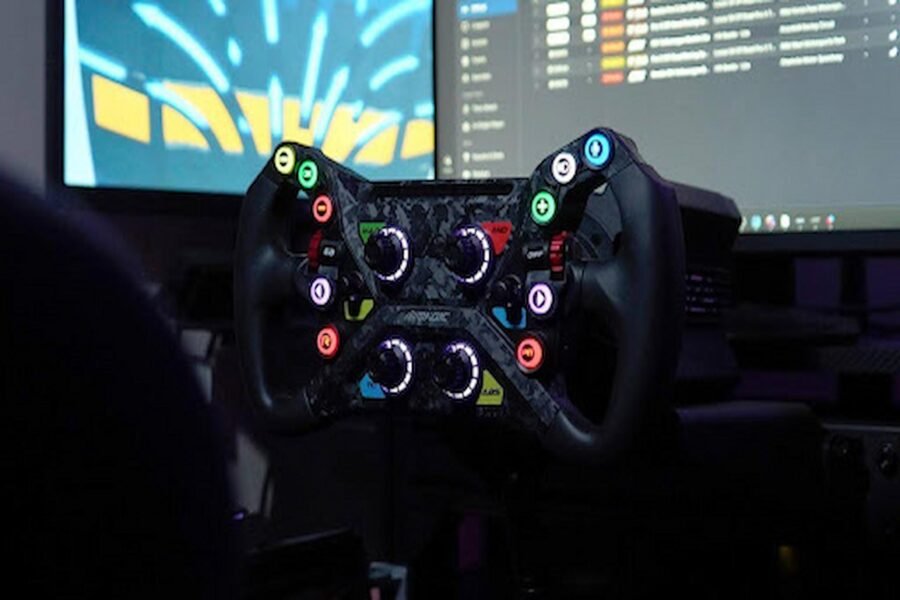Choosing the right racing wheel can transform your simulator experience. When selecting a Simagic Steering Wheel, it is vital to consider performance, build, comfort, and compatibility. This guide explores the essential features you should evaluate before investing in your setup.
Racing simulation has developed into a highly advanced sport, offering equipment designed to mirror the feel and precision of real-world driving. At the heart of any setup lies the steering wheel, which acts as the direct connection between the driver and the simulator. Its role goes far beyond simple control; the wheel defines the realism, responsiveness, and overall immersion of your racing sessions. Choosing the right steering wheel can significantly influence both performance and enjoyment, making it one of the most important investments for any serious enthusiast. With many options available, it becomes vital to focus on the features that matter most—build quality, functionality, comfort, and compatibility. A well-chosen wheel ensures not only a competitive edge but also a more engaging, lifelike experience. When considering a Simagic Steering Wheel, carefully evaluating these elements will help you create a setup that matches your goals and enhances your racing ambitions.
Build Quality and Durability
The first thing to examine is how well the wheel is built. A steering wheel endures constant pressure, so it must be robust. Premium materials like aluminium and carbon fibre are often used to ensure rigidity and longevity. You should also look at the grip quality. Leather, suede, or textured rubber not only enhances comfort but also provides better control.
A sturdy wheel means more stability during intense racing sessions. A flimsy build can reduce precision and affect long-term reliability. For a professional racing setup, build quality cannot be compromised.
Wheel Size and Design
The size of the wheel directly affects handling. Smaller wheels offer quicker response and are often favoured in formula-style simulators. Larger wheels mimic road and GT cars, offering a more relaxed but realistic feel.
Design plays a role, too. You may want a wheel for versatility or a formula-style cut for specialised racing. Ensure the design aligns with the type of simulator experience you prefer.
Button Layout and Functionality
Modern racing simulators require multiple inputs, and the button layout becomes critical. A good wheel should have easily accessible buttons, rotary encoders, and paddle shifters. The positioning must allow you to make quick changes mid-race without losing focus.
Magnetic paddle shifters are particularly sought after because they provide crisp feedback and reliability. Some wheels also include thumb encoders, toggle switches, or multi-function displays. Each feature enhances adaptability across different racing scenarios.
Quick Release System
Convenience is a key factor. A high-quality quick-release system allows you to change wheels effortlessly. This is useful if you own multiple wheel rims or prefer switching between GT and formula racing styles.
Simagic’s proprietary quick-release design is both secure and seamless, ensuring there is no play or looseness. A dependable connection improves immersion by making the steering response sharper and more direct.
Force Feedback Precision
The primary role of a racing wheel is to deliver accurate feedback from the track to the driver. Force feedback is the feature that separates casual gaming from a professional-grade simulator. A Simagic Steering Wheel is designed to provide this realism with advanced precision. Key aspects to look for include:
- Smooth and consistent torque delivery for natural control
- High refresh rate for quick and responsive inputs
- Accurate simulation of road textures and vehicle behaviour
When these elements are fine-tuned, every corner, bump, and slide feels authentic, creating a truly immersive driving experience.
Compatibility with Bases and Pedals
Not all steering wheels are universally compatible. Before purchasing, confirm whether the wheel integrates with your chosen wheelbase and pedal set. Simagic products are designed for seamless ecosystem use but may also connect with third-party hardware through adaptors.
Checking software support is equally important. Ensure firmware updates and calibration tools are accessible, as these contribute to smoother performance and longer usability.
Comfort and Ergonomics
Comfort plays a significant role in extended racing sessions. An ergonomic design prevents hand fatigue, especially during endurance races. A balanced weight distribution, high-quality grips, and thoughtful button positioning all contribute to ease of use.
Test how the wheel feels during long stints. An uncomfortable setup can quickly affect your performance.
Adjustability and Customisation
- Every racer has unique preferences when it comes to handling and control.
- Some may prefer softer paddle feedback, while others enjoy firmer resistance.
- Adjustable options like button remapping and encoder sensitivity add versatility.
- Customisable grips improve comfort and allow a tailored fit for different users.
- These features let you fine-tune the wheel for various racing styles, including drifting, endurance events, and time attack challenges.
Value for Money
A good steering wheel is an investment. While premium models can be costly, they often deliver performance, comfort, and durability that justify the price. Always weigh the wheel’s features against its cost.
Consider long-term value: a higher upfront price may save money by providing a longer-lasting and more immersive experience.
Final Thoughts
Selecting a Simagic Steering Wheel requires careful attention to details such as build quality, functionality, compatibility, and comfort. Each feature contributes to immersion and performance, making your racing sessions more enjoyable and competitive.
By choosing wisely, you create a setup that matches your racing ambitions and provides lasting satisfaction.



